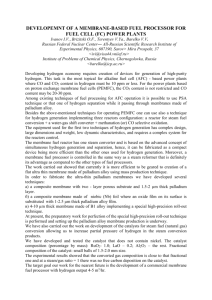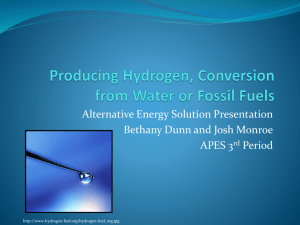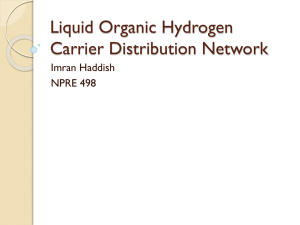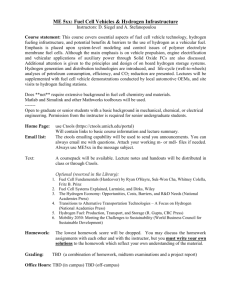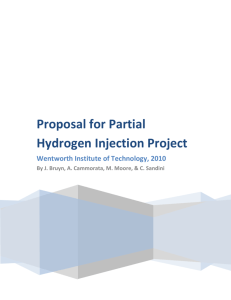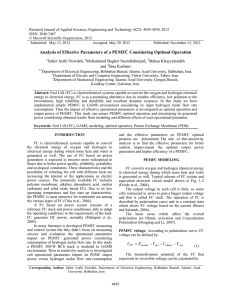Proton Exchange Membrane Fuel cell
advertisement
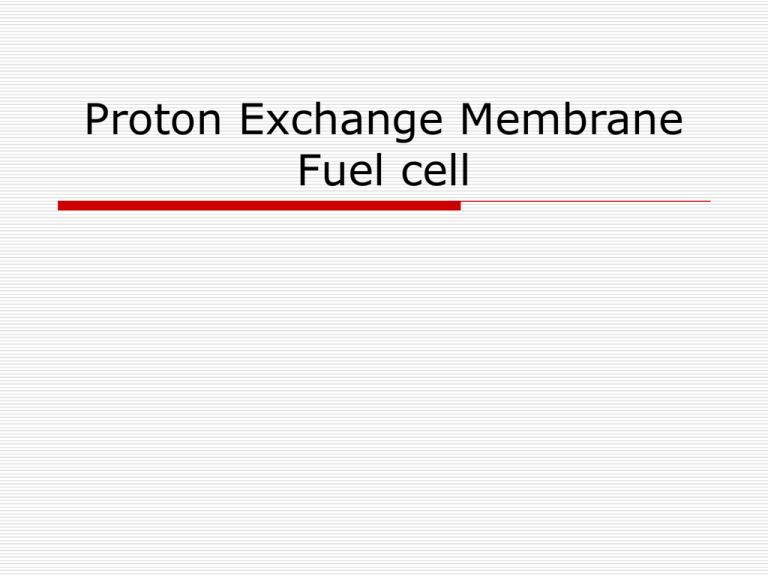
Proton Exchange Membrane Fuel cell History Invented in early 1960’s at General electric First used by NASA to provide power for gemini space project Operation In PEMFC, the electrolyte used is a thin polymer membrane (such as poly[perfluorosulphonic] acid, which are permeable to protons but does not conduct electrons Hydrogen flows into the fuel cell onto the anode and is split into hydrogen ions and electrons Cont.. Hydrogen ions permeate across the electrolyte to the cathode Electrons flow through an external circuit and provide power Oxygen is supplied to the cathode and this combines with electrons and hydrogen ions to produce water PEMFC operate at a temperature of around 80°C Cont.. Cont.. Electrolyte is sandwiched between two field flow plates to create a fuel cell Each cell produces around 0.7 volts, about enough power to run a light bulb To generate high voltage, a number of individual cells are combined in series Advantages Operate at low temperatures which allows them to start up rapidly from cold High power density which makes them really compact and lightweight PEMFC work at high efficiencies, producing around 40-50 percent of the maximum voltage, and can vary their output quickly to meet shifts in power demand Disadvantages Needs pure hydrogen to operate as they are very susceptible to poisoning by carbon monoxide and other impurities Current research At present, demonstration units capable of producing 50kw are in operation and units producing 200kw are under development Still number of barriers need to be overcome The main issue is that the cost of membrane and catalysts are expensive but the ongoing research and development is constantly reducing the cost. Applications In 1995,Ballard systems tested PEM cells in buses in Chicago and later in experimental vehicles made by Daimler Chrysler In 2000,AeroVironments selected PEM technology to provide night time power for its solar powered Helios long duration aircraft Q&A 1.What is the operating temperature for PEMFC? 1000°C 500°C 250°C 80°C Cont.. 2.What is the electrolyte used in PEMFC? Lithium sodium carbonate salts Liquid phosphoric acid Potassium hydroxide Perfluorosulphonic acid Cont.. 3.What is the amount of voltage produced by each cell in PEMFC? 10 V 20 V 5.5 V 0.7 V Cont.. 4.Which of the following matches the needs and characteristics of PEMFC? Pure hydrogen Feedstocks free from carbon-dioxide Membrane materials and catalysts are inexpensive Capable of producing output equivalent to 50kw Cont.. 5.Which of the following are susceptible to CO? PEM fuel cell Alkaline fuel cell Solid oxide fuel cell Molten carbonate fuel cell Storage medium for Hydrogen Storage methods Hydrogen can be stored as compressed gas or as a cooled liquid Despite these methods storing hydrogen to power a car requires a large tank Obstacle With the current technology, the compressed hydrogen tank size required to contain 6.8 kg hydrogen for a 1500 kg vehicle with a driving range of 560km is 340 litres. A typical gasoline tank for such a vehicle is 70 litres Current trend Currently the hydrogen is injected directly into the cell There is a tank which holds methanol Methanol and water vaporize forming hydrogen


